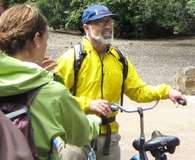Pedal pusher: Engineering professor, students plan citywide bike paths

(�鶹��ԺOrg.com) -- An earthy mobile of cyclists hangs above Peter Furth’s office computer. A gift from his children, the dangling artifact originates from an African country where bikes are a primary mode of transportation, and is a manifestation of the civil and environmental engineering professor’s passion: bicycles as transport.
“I love public transportation and bicycling because I love active living,” Furth says. “So many people enjoy the convenience of slipping into a car and commuting that way, but I think these people are losing their lives — they’re never outdoors.”
By contrast, there is nothing better than arriving to work red-faced from the wind, lungs and heart pumping, and blood flowing with vitality, he says. Furth and like-minded civil engineering students recently returned from a faculty led study abroad trip to the Netherlands, where they learned about a culture and infrastructure built for bicycle riders. “They have a system that is built to promote walking and cycling,” Furth said.
He noted that 75 percent of school children in the Netherlands ride bikes or walk to school. By contrast, the number of U.S. school children who walk or bike to school are in the single percentages, he said.
Praising the city of Davis, Calif., for its adaptation of bike paths into the infrastructure, Furth hopes Boston will pick up on the idea. He and a team of Northeastern civil engineering students who studied in the Netherlands are working on 11 citywide projects aimed at building better bike paths for those wishing to commute.
Students have been studying the former bridle paths of the Emerald Necklace, a seven-mile stretch winding from the Public Gardens in Boston through Jamaica Plain and winding up in Franklin Park, to look for ways to link the old pathways together. In many portions, roadways overlap the paths and would require reconfiguration or redesign, signals, or even bridges, for safe passage.
“Our goal is to find ways to allow people to be able to bike around, either to and from work, or on errands,” Furth said. “We have a network problem. You can’t have people ride more bikes unless they can get from point to point in a safe, pleasant way.”
Students are seeing the green light in at least one interchange. The rotary that connects Park Drive, the Riverway and Brookline Avenue, is destined to become more passable for cyclists as part of a new redesign.
Furth’s students are in part responsible. The Army Corps of Engineers recently heard student testimony at a public hearing on the Muddy River Project supporting the addition of bike paths to the interchange. Furth said their testimony and research helped support a design change that will allow for bike paths once the new interchange is built in two years.
“The Army Corps completely changed their design to make it safer for bikes after they heard the testimony of our students,” Furth said. “We’ve got 11 projects in the city, and I hope, in time, they will result in safer bike routes throughout Boston.”
Provided by Northeastern University





















